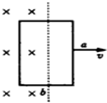问题
选择题
| 如图所示,矩形线圈有N匝,长为a,宽为b,每匝线圈电阻为R,从磁感应强度为B的匀强磁场中以速度v匀速拉出来,那么,产生的感应电动势和流经线圈中的感应电流的大小应为( ) A.E=Bav, B.E=NBav, C.E=Bav, D.E=NBav,  |
答案
答案:D
| 如图所示,矩形线圈有N匝,长为a,宽为b,每匝线圈电阻为R,从磁感应强度为B的匀强磁场中以速度v匀速拉出来,那么,产生的感应电动势和流经线圈中的感应电流的大小应为( ) A.E=Bav, B.E=NBav, C.E=Bav, D.E=NBav,  |
答案:D